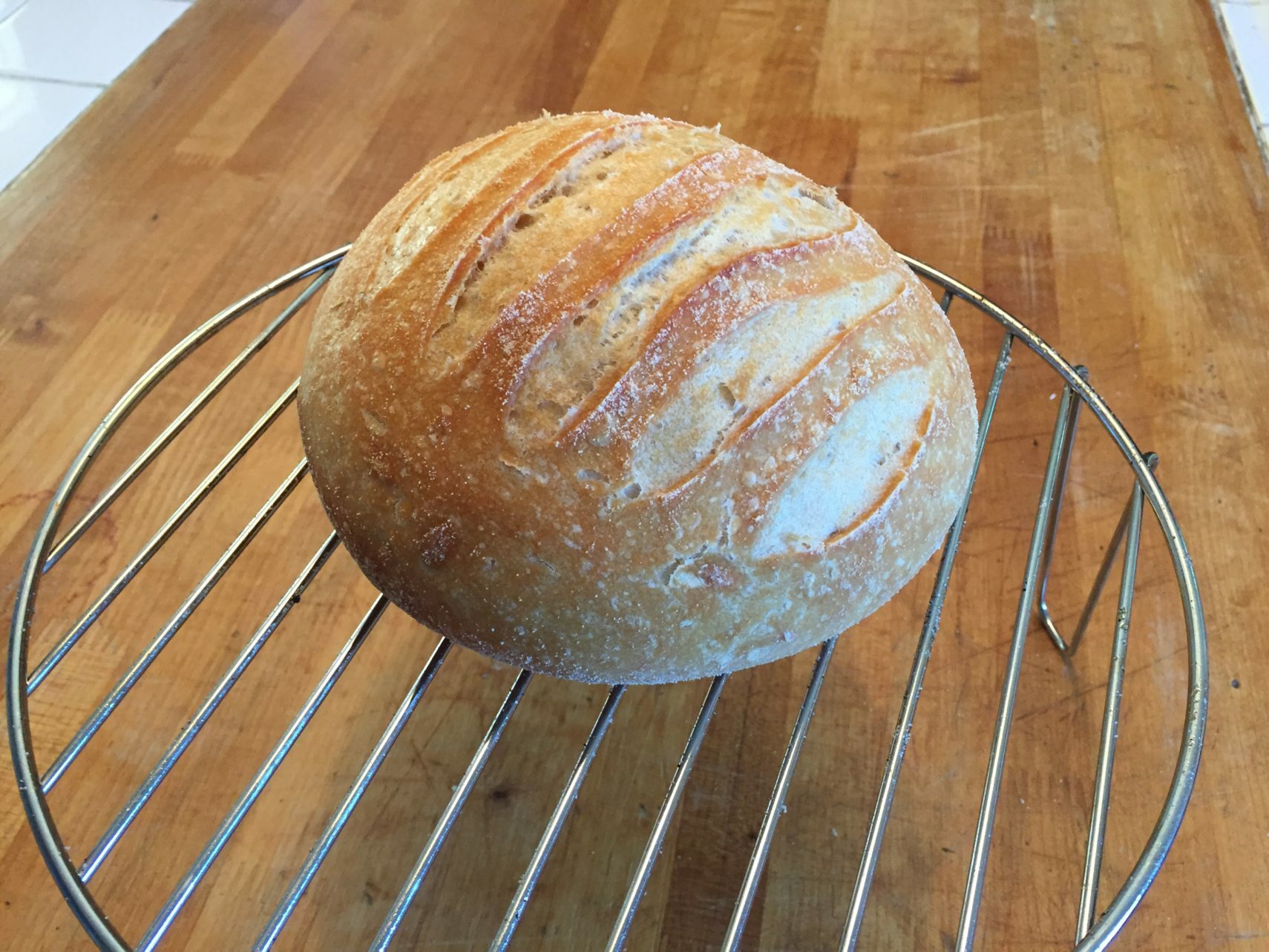As the health and fitness sphere moves toward becoming less carb-phobic, many of us are recognizing our need (especially as athletes) to incorporate more carbs. At first, this may lead to sweet potato redundancy, because sweet potatoes have long been safely marked as “paleo.” But there are many, many other forms of starchy carbohydrate, and it’s good to get diversity in your diet—not just for the beneficial assortment of micronutrients, but also for your mental relationship with food. No high-quality real food item should be off-limits to you, unless, of course, you have a known food allergy.
Real sourdough bread, even for many who are sensitive to wheat, can be an excellent carb source, and, more importantly, a delicious delivery vehicle for eggs, avocado, and oh-so-much-more. The trick is to make sure you’re getting the real stuff. So-called sourdough from your local grocery store—even Whole Foods!—is garbage. Just look at the ingredients on the back. Sourdough bread should only have three ingredients: flour, water, salt, and cultured wheat (which is a combination of wild yeast and bacteria). Inspecting sourdough loaves from my conventional neighborhood store reveals ingredient lists of 20+ random things, like canola oil and sugar… yum (not).
Fortunately, many farmer’s markets have a sourdough baker, and more and more restaurants are popping up featuring house-made sourdough bread and even pizza crusts. These bakers are usually more than happy to talk with you about their process, as everyone makes sourdough in a different way that reflects their tastes and style. Here are some things to ask:
- How much culture did you use and how long did you ferment the bread?
- It’s a common misconception that a “long slow fermentation” is best. Fermentation time is just one element in the sourdough equation. Another crucial factor is the amount of bacteria starter used. Let’s say only 5% of the dough is made of starter. It’s going to take a long time to ferment the bread so it gets sour (which indicates the gluten has been broken down and the bread is rich in pro and prebiotics). Alternately, let’s say the dough is comprised of 50% starter. It’s going to ferment a whole lot quicker than the 5% loaf.
- What temperature do you let the dough ferment at?
- Another factor that impacts fermentation time is temperature. You’ve seen this before in regular life: when it’s hot, the trash stinks a lot quicker than when it’s cold. The same goes with the bacterial activity of sourdough. Bakers often control the temperature of their kitchens so the sourdough behaves predictably. If the doughs are stored at 50º, they’re going to take much longer to ferment than a dough sitting at 75º.
You don’t have to be a mathematician or a professional baker (same thing, kind of) to figure out the equation for the highest quality sourdough loaf. An easy way to gauge it is just by using your senses. Heavily fermented sourdough bread doesn’t look very pretty. It lacks that nice round rise of a conventionally made, yeasty bread. Quite the opposite, real sourdough looks like a brick: flat and dense. The other way to assess the sourdough’s fermented quality is to taste it. You know how apple cider vinegar leaves that tang near the middle/back of your tongue? Sourdough should do the same thing, but a little less extreme. If you’re wondering, “Is this sour?” then the answer is, “No, it’s not sour enough.” Truly fermented sourdough bread tastes unquestionably sour.
So why do you want sour sourdough again? Here’s all the goodness fermented bread has to offer (backed by peer-reviewed science!):
- Sourdough fermentation reduces the glycemic index of wheat1
- Sourdough bread is lower in FODMAPs than conventional wheat bread2
- Sourdough fermentation increases mineral bioavailability and reduces phytate content3
- Properly fermented sourdough bread is gluten free and tolerated by people with celiac disease4
- BUT, if you have a serious health condition, be very careful about trying sourdough breads because most are not fermented to this extreme
- Sourdough positively impacts the gut microbiome, in some studies,5 but others show no change.6 I suspect this might be a limitation in the study’s access to truly fermented sourdough bread, as the researchers don’t specify how they acquired their test subject.
Apparently, science also suggests that sourdough bread is superior in flavor and texture7 to conventional bread. So slather on the butter or avocado and enjoy your sourdough!
References
1. Wolter, A., Hager, A.-S., Zannini, E., & Arendt, E. K. (2014). Influence of sourdough on in vitro starch digestibility and predicted glycemic indices of gluten-free breads. Food & Function, 5(3), 564–572. https://doi.org/10.1039/c3fo60505a
2. Laatikainen, R., Koskenpato, J., Hongisto, S.-M., Loponen, J., Poussa, T., Huang, X., … Korpela, R. (2017). Pilot Study: Comparison of Sourdough Wheat Bread and Yeast-Fermented Wheat Bread in Individuals with Wheat Sensitivity and Irritable Bowel Syndrome. Nutrients, 9(11). https://doi.org/10.3390/nu9111215
3. Wolter, A., Hager, A.-S., Zannini, E., & Arendt, E. K. (2014). Influence of sourdough on in vitro starch digestibility and predicted glycemic indices of gluten-free breads. Food & Function, 5(3), 564–572. https://doi.org/10.1039/c3fo60505a
4. Gobbetti, M., Giuseppe Rizzello, C., Di Cagno, R., & De Angelis, M. (2007). Sourdough lactobacilli and celiac disease. 3rd International Symposium on Sourdough, 24(2), 187–196. https://doi.org/10.1016/j.fm.2006.07.014
5. Costabile, A., Santarelli, S., Claus, S. P., Sanderson, J., Hudspith, B. N., Brostoff, J., … Gibson, G. R. (2014). Effect of breadmaking process on in vitro gut microbiota parameters in irritable bowel syndrome. PloS One, 9(10), e111225. https://doi.org/10.1371/journal.pone.0111225
6. Korem, T., Zeevi, D., Zmora, N., Weissbrod, O., Bar, N., Lotan-Pompan, M., … Segal, E. (2017). Bread Affects Clinical Parameters and Induces Gut Microbiome-Associated Personal Glycemic Responses. Cell Metabolism, 25(6), 1243–1253.e5. https://doi.org/10.1016/j.cmet.2017.05.002
7. Arendt, E. K., Ryan, L. A. M., & Dal Bello, F. (2007). Impact of sourdough on the texture of bread. Food Microbiology, 24(2), 165–174. https://doi.org/10.1016/j.fm.2006.07.011
—Samantha Morse

